Some people believe that espresso making is a skill. Others believe it to be an art. But the most experienced baristas would probably say that it is a combination of the two.
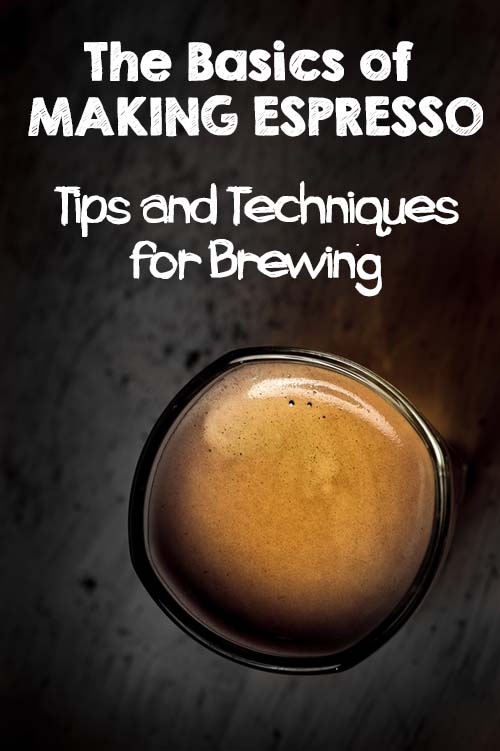
Granted, when the barista at your favorite coffee house makes a heart or leaf on your latte, it is lovely and probably means that the milk has been steamed well.
However, that foam art does not guarantee that your espresso has been brewed properly. Creating your favorite coffee drinks to perfection has to do with more than just making them pretty.
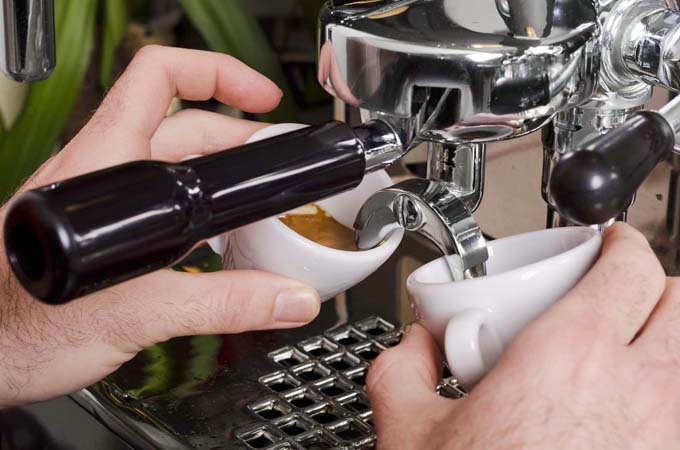
But it is a craft that almost anyone can learn to do by carefully following just a few simple guidelines. Read on to learn the basics of brewing espresso.
The Beans
First things first. Know the particulars of the coffee beans you are using and how to best extract their flavor.
There is a misconception that the word “espresso” implies a certain type of roast or bean. Although some coffee roasters do create roasts that they label as “espresso,” the brewing method is actually what makes it so.
This means that you are free to begin with any type of bean or roast that you prefer.
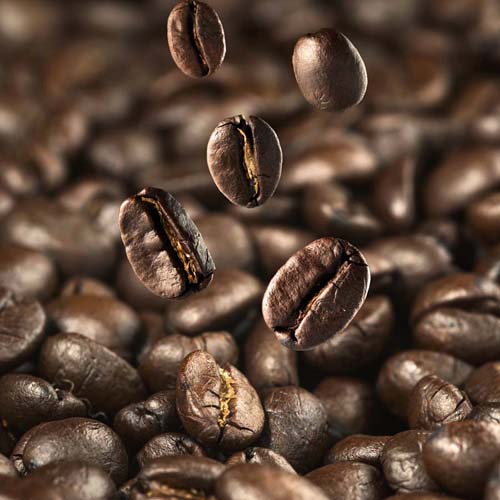
There are, however, certain roasts that are more conducive to this type of brewing, and many people prefer the results given by a darker roast. This is the tradition from southern Italy that has influenced many coffee lovers in the United States.
Where coffee beans are concerned, a fresher roast is better. Unroasted beans (called green beans) can be stored for long periods of time, but once they are roasted it is best to use the beans within two to three weeks for the finest flavor, although freezing them can extend their shelf life.
Look on your package for the date on which it was roasted. If the package does not specify, it has probably been sitting on the shelf for awhile and the beans are stale .
You may want to find a different source for your beans. Some folks even like to roast their own to get the ultimate in freshness.
Bean Acquisition Tips
Hundreds of various coffee roasters sell their beans only and offer expedited shipping for freshly roasted beans, or you may be able to find some locally.
The Grind
Because of the process used to pull the flavor out of the beans, the consistency of the grind is important in espresso brewing. Using a burr grinder is really the only way to get the most effective and consistent grind.
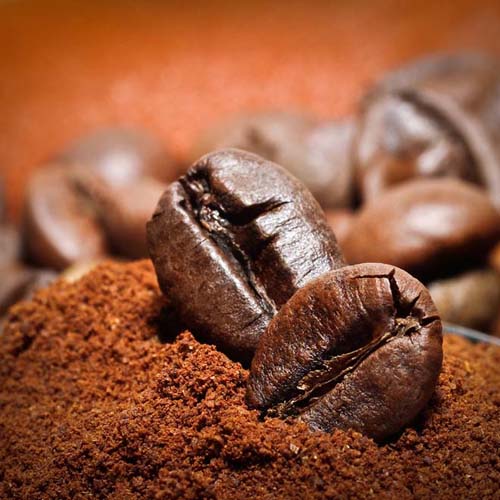
Since particles that are finely ground have a greater surface area, the flavor can be extracted from the grounds faster.
Coarse ground beans will not allow the water to pull the flavor from the beans if you are using a quick brewing method, but will work better for a slower method such as a french press instead (what is this?).
The best consistency for an espresso grind should be rather fine, while still retaining the appearance of individual grains that stick together somewhat when pinched– not quite as fine as powdered sugar, but finer than regular sugar.
A grind that is extremely fine and powdery will over extract and create a brew with bitter qualities.
Coffee Grinder Tips
You’ve probably read ad nauseam either from us or other resources on the net that the quality of the coffee grinder is paramount to the taste in any brewing system, and it is critical for proper espresso extraction.
It is more important, by far, than the quality of the espresso machine. Please do yourself a favor and purchase the best grinder that you can afford, even if it means waiting for the espresso machine of your dreams.
The Water
All water is not created equal. Minerals and impurities in water used in the brewing process will directly affect the taste, so it is best to use purified water.
Also, the temperature of the water is important. Boiling water will overheat the coffee and kill the flavor. In contrast, water that is not hot enough can make a flat and tasteless drink.
Normally, 200°F is the best temperature at which to brew espresso.
Many aficionados hook their espresso machines up to water filtration systems such as the Mavea Purity C Water Filter System (less expensive Hydrogen Ion Exchange) or in extremely hard water areas or for commercial use, the Mavea Purity ST Water Filtration System (Sodium Ion Exchange).
The Measure
Dumping a pile of grounds into your pot each morning might work out okay for just your average cup of joe.
But for a fine espresso, it is important to measure the amount of grounds you are using. A single shot should use around 3 tablespoons of ground coffee, depending on the freshness of the grind, and should be ground directly into a clean, dry portafilter.

The coffee should create a small mound above the top of the basket, and should then be leveled across the surface. Leveling ensures that there are no uneven pockets of air caught inside.
Many people measure their grounds with a scale for accuracy. A few grinders, such as the Baratza Vario-W and Forte models, feature built in scales that do the measuring for you.
Also, the Baratza Esatto Scale is an attachment that can be added to Baratza’s lower cost conical models such as the Encore, Virtuoso, and Preciso.
Other models such as the MACAP M7, Compak K8 Fresh, Mazzer Super Jolly Electronic, and the Mahlkonig K30 Vario offer advance time based measuring (also called dosing).
The Tamp
Tamping, or compacting, the grounds into the filter is an important step in the brewing process. Pressing down on the tamper with firm, consistent pressure is the way to achieve this.
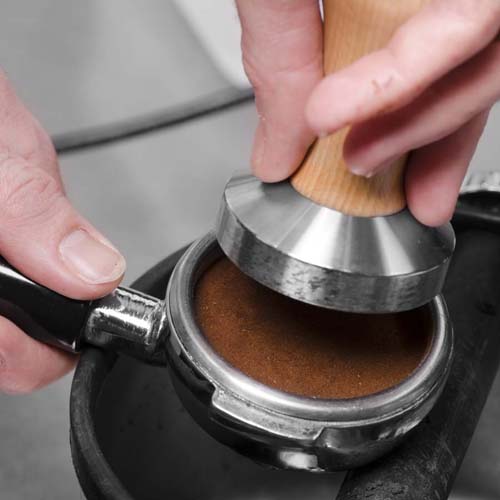
In order for espresso to be extracted properly, it must be packed densely enough to allow the water to pull out the flavor while the water is being forced through the grounds.
Your tamper should pack the grounds into the basket firmly to create a smooth surface. “Fluffy,” untamped grounds will not allow for the flavor to be evenly extracted.
Although simple in concept, tamping is an intricate that must be acquired through practice. Advanced baristas can utilize their tamping skills to “compensate” for a grind that is not quite perfect.
If it is too fine, you can tamp with less pressure to counteract this, or tamp with more pressure to make up for too loose a grind. Once the coffee has been tamped, treat it carefully to avoid creating a disturbance in the tamping.
Brush off any extra powder around the outside to clear the way for a clean pull.
Tamping Tips
Brew temperature, tamping pressure, grinding levels, bean variety and roast level, and even environmental factors such as humidity are all variables that make a difference within the espresso extraction process.
The key to espresso brewing is consistency, and any time one of these variables can be eliminated it will improve your ability to dial in the shots.
Many folks who are new to espresso brewing have trouble getting their tamping skills down so that they are tamping at a consistent pressure each and every time.
However, there is a product that can mitigate a lack of barista experience.
This is the Espro Calibrated Tamper.
You merely press down with the device and twist as you would with a normal tamper, but the Espro features a spring loaded insert that gives an audible and tactile sensation when 30 lbs. of pressure is reached.
The customer reviews on Amazon attest to the usefulness of this device for the new home or professional barista.
The Brewing
Before starting each cup, the head of the machine must be flushed. This clears any old coffee from the screen, and allows fresh water to flow.
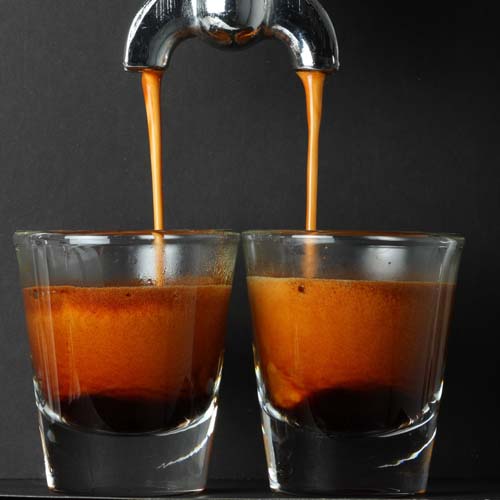
Flushing for 3-5 seconds should be enough for E61 Brew Group equipped machines, even less for double boilers.
After inserting the portafilter with tamped grounds into the machine, turn to make sure it is properly secured.
Once the extraction process begins, you will see a stream that is thin and dark. As it moves through the process, the stream will lighten and thicken a bit.
If you see a pale, almost transparent stream, the brewing process should be finishing up. This should take around 25 seconds. If it takes more or less time, adjust your grinder accordingly.
If you see a blond stream as you are beginning the pull, this is known as “channeling.” This is not good, as water is forcing a hole through the grinds, leading to a severely under-extracted shot.
Click here to read our Portafilter Guide and find out more about the affects of channeling and measures that you can take to combat it.
Size vs. Extraction Length
A single shot of espresso or a “solo” is generally one fluid ounce (30 ml), while a double or “doppio” is usually two fluid ounces (60 ml). A triple or “triplo” rounds out the measurements for standard shots at the three fluid ounce mark (90 ml).
These shots use a proportionate quantity of coffee grounds, around 7-8, 14-16, and 21-24 grams respectively.
The single shot is considered the classic shot volume, being the greatest amount that could effectively be drawn using the older spring lever machines, although the double is now considered to be the standard volume.
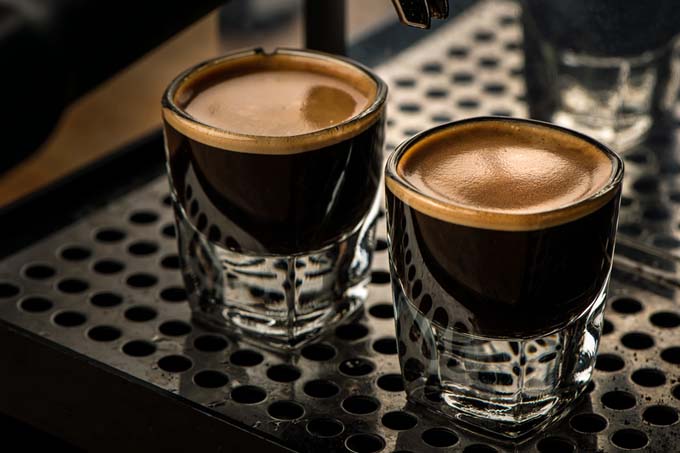
Once you get into more advanced espresso brewing techniques, you will find that the taste, texture, and quantity can also be affected by the extraction length or the amount of time over which the espresso is pulled.
This is often confused with the size of standard espresso shots, but the terminology actually refers to the amount of heated water that is allowed to pass through the puck (another name for the coffee grounds held in the portafilter basket) for any given quantity of grounds.
However, merely adjusting the time that the shot is pulled may result in under (weak and/or sour) or over (bitter) extraction. Instead of the amount or weight of grinds being adjusted as in the single/double/triple examples, the particle size of the grounds is modified at the grinder to dial in the espresso pull to the “sweet spot.”
The length of the shot is then adjusted based off of the grind level, to get the taste that is desired.
This technique can produce at least four different types of espresso beverages. The first three include the ristretto, the normale, and the lungo.
The ristretto is believed to be the absolute best and is the smallest portion of pure espresso at just three-quarters of an ounce to one fluid ounce. This drink is generally a 1:1 ratio of coffee grounds to water.
A normale is around two fluid ounces, usually a 1:2 ratio. A lungo is usually a three to four fluid ounce serving, and is normally a 1:3 or 1:4 ratio.
To reiterate as this can be confusing, the grind level of the coffee grounds is fine-tuned, with the ristretto receiving a much finer grind than that of the lungo, with the normale being somewhere in the middle.
A fourth type, one that is much more rare, is the caffe crema. It its generally 4-8 fluid ounces, featuring a much coarser grind than the standard ristretto, normale, or lungo.
Dialing It All In
Using a new espresso machine may take some getting used to. It might take several tries and adjustments in the process in order to find the “sweet spot” for your machine.
To perfect your craft, keep a notebook of the changes you have made each time. Then make adjustments to find the most even, smooth cup of espresso that is perfect for your personal taste.
This is where the heart of the artist comes into play.
And if it takes lots of practice?
Well, that is just a good excuse to do “research” while drinking numerous cups of your favorite beverage.
Also, don’t forget to clean your machine – old and dried-on gunk can have a noticeable impact on flavor, in addition to clogging things up!
Serve with a side of biscotti, and savor every moment and taste!
About Mike Quinn
Mike Quinn spent 20 years in the US Army and traveled extensively all over the world. As part of his military service, Mike sampled coffee and tea from all virtually every geographic region, from the beans from the plantation of an El Salvadorian Army Colonel to "Chi" in Iraq to Turkish Coffee in the Turkish Embassy in Kabul, Afghanistan. He spent nearly a decade in the Republic of Korea where he was exposed to all forms of traditional teas. Mike formerly owned and operated Cup And Brew, an online espresso and coffee equipment retail operation.

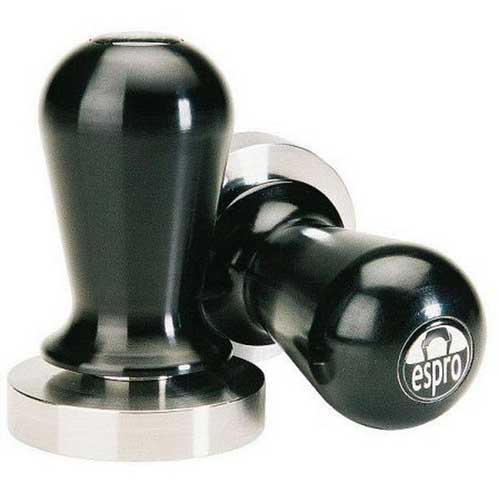

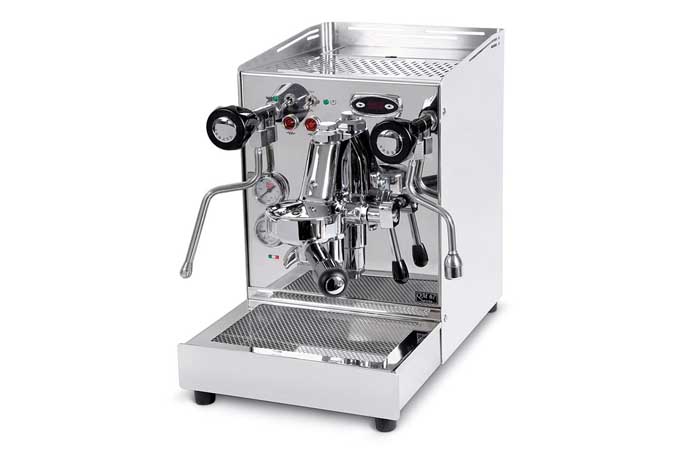
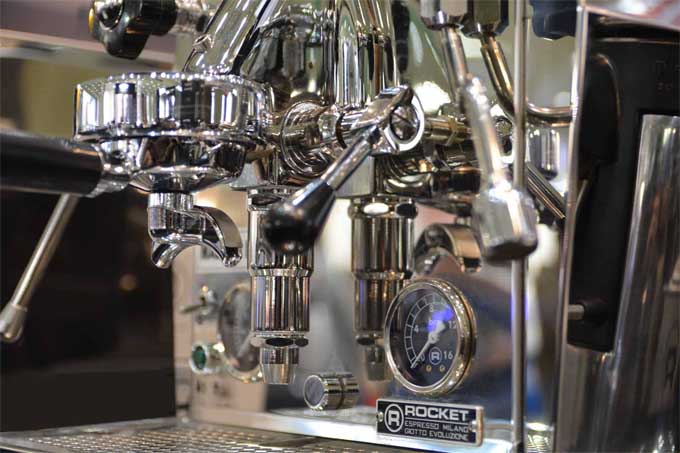
Wow, this is an in depth article. This is great information which I will refer to should I want to make it from scratch. At this time I much prefer to drink it in a coffee bar. I do love espresso and I am grateful for all this information!
I love espresso! I would recommend to anyone who is getting into this to not buy a hand grinder though. I thought it looked nifty, and it was so much cheaper, but it takes a huge amount of time to grind even a small amount of beans! The tip about keeping the machine clean is really important too. Nothing ruins coffee like a stale machine.
I have learned something new today. I never knew what “tamping” was at all. I usually just put the ground coffee in the paper filter. I guess this just comes to show how much I have to learn about coffee. Although I have never tried making expresso before let alone drink it.
I love coffee and on bolder days love to get an espresso with friends. I’ve never thought to make it myself, because it always seemed like soo much work. This post gives such great detail and makes me want to try making my own. I can’t wait to discuss the buying a machine with my roommate and trying out some of our own recipes.
Thanks for the informative guide! I recently received an espresso machine for Christmas from my siblings, and I’ve been addicted to using it since! I’ve probably ingested way too much caffeine in the past month, but it tastes so good! hopefully I can make them taste better with all these tips, if I can remember them all. I might just print out a copy an keep it in my recipe binder as a reference guide!
This post is very detailed and demonstrates the basics of espresso making extremely well. Although, these have a very high amount of caffeine in them so be weary. Do not drink too many.
I have always wanted to try my hand at making fresh espresso. Right now I am actually using the stuff that comes in the squeeze tube that you can add to milk..I use about two shots. Though delicious, I love homemade espresso. My mother actually introduced this deliciousness at a Sunday brunch we were having in the back yard. It was an experience I will never forget.
I read somewhere that pre-heating the cup would result in a greater taste. Is it true?
I have an basic espresso machine with a water resevoir but its so much better than drip coffee. Thanks for the good tips. Especially the Flushing. Now I undersand the logic about the tamping.